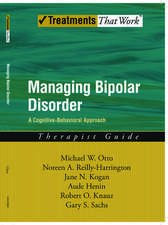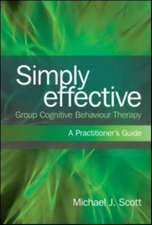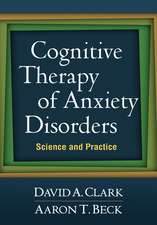Schema Therapy: A Practitioner's Guide
Autor Jeffrey E. Young, Janet S. Klosko, Marjorie E. Weishaaren Limba Engleză Paperback – 7 dec 2006
| Toate formatele și edițiile | Preț | Express |
|---|---|---|
| Paperback (1) | 361.94 lei 3-5 săpt. | +27.50 lei 4-10 zile |
| Guilford Publications – 7 dec 2006 | 361.94 lei 3-5 săpt. | +27.50 lei 4-10 zile |
| Hardback (1) | 673.34 lei 6-8 săpt. | |
| Guilford Publications – 15 mai 2003 | 673.34 lei 6-8 săpt. |
Preț: 361.94 lei
Preț vechi: 380.98 lei
-5% Nou
69.25€ • 72.32$ • 57.19£
Carte disponibilă
Livrare economică 25 martie-08 aprilie
Livrare express 08-14 martie pentru 37.49 lei
Specificații
ISBN-10: 1593853726
Pagini: 436
Dimensiuni: 156 x 234 x 27 mm
Greutate: 0.62 kg
Ediția:1
Editura: Guilford Publications
Colecția Guilford Press
Public țintă
Professional Practice & DevelopmentCuprins
2. Schema Assessment and Education
3. Cognitive Strategies
4. Experiential Strategies
5. Behavioral Pattern-Breaking
6. The Therapy Relationship
7. Detailed Schema Treatment Strategies
8. Schema Mode Work
9. Schema Therapy for Borderline Personality Disorder
10. Schema Therapy for Narcissistic Personality Disorder
Notă biografică
Janet S. Klosko, PhD, Codirector of the Cognitive Therapy Center of Long Island, in Great Neck, New York, is senior psychologist at the Schema Therapy Institute and at Woodstock Women's Health in Woodstock, New York.
Marjorie E. Weishaar, PhD, is Clinical Professor of Psychiatry and Human Behavior at Brown University Medical School, where she teaches cognitive therapy to psychiatry residents and to psychology interns and postdoctoral fellows. She also maintains a private practice in Providence, Rhode Island.
Recenzii
This volume demonstrates in a skillful, highly readable fashion how the standard cognitive therapy approaches to Axis 1 disorders can be expanded and modified to treat personality disorders. Working within a comprehensive cognitive model, the authors draw on a variety of strategies to address the specific problems in this population: rigid, lifelong maladaptive characterological patterns; chronic interpersonal difficulties; and transference reactions. The book shows how to attenuate the powerful beliefs underlying these patterns through exploratory and experiential strategies. Highly recommended for all therapists engaged in treating patients with these very difficult personality problems.--Aaron T. Beck, MD, Department of Psychiatry, University of Pennsylvania
The work of Jeffrey E. Young and his colleagues represents both a major contribution to the evolution of cognitive and cognitive-behavioral therapy and an important step toward enhancing the prospects for integrating cognitive therapy with other approaches, particularly psychoanalysis. This book presents schema therapy in clear and generous detail and offers much to the experienced practitioner and the student. A highly valuable and worthwhile contribution.--Paul L. Wachtel, PhD, Doctoral Program in Clinical Psychology, City College, City University of New York
Young et al. have developed an innovative, rich, and intuitively healing approach to therapy based on years of clinical experience and research. Schema therapy incorporates wisdom from a variety of approaches to bring fresh new perspectives to traditional cognitive therapy. In this book, clinicians will find up-to-the-minute, empirically supported approaches to treating such difficult problems as narcissistic and borderline personality disorders. Strategies and procedures are laid out in a clear and compelling manner, including invaluable advice on implementation. All clinicians wishing to incorporate schema-based cognitive approaches into their practices will find this book an invaluable resource and a pleasure to read.--David H. Barlow, PhD, Center for Anxiety and Related Disorders, Department of Psychology, Boston University
Descriere
Designed to meet the formidable challenges of treating personality disorders and other complex difficulties, schema therapy combines proven cognitive-behavioral techniques with elements of other widely practiced therapies. This book--written by the model's developer and two of its leading practitioners--is the first major text for clinicians wishing to learn and use this popular approach. Described are innovative ways to rapidly conceptualize challenging cases, explore the client's childhood history, identify and modify self-defeating patterns, use imagery and other experiential techniques in treatment, and maximize the power of the therapeutic relationship. Including detailed protocols for treating borderline personality disorder and narcissistic personality disorder, the book is illustrated with numerous clinical examples.
























